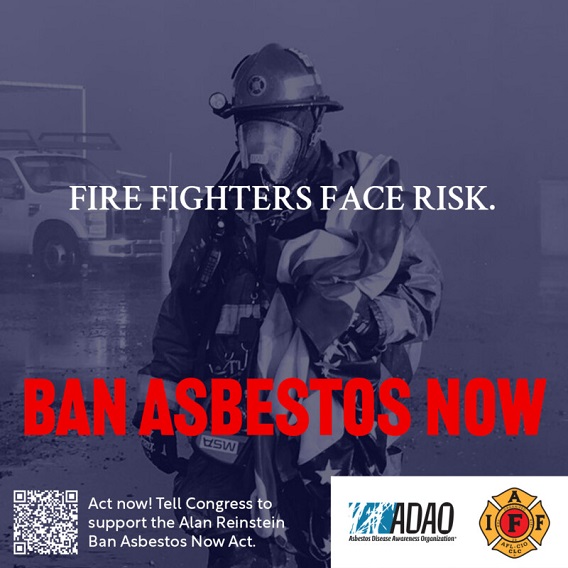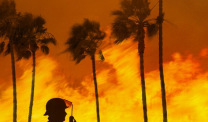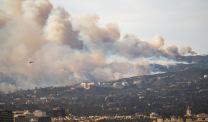Nonprofit Teams With Firefighter Union for Asbestos Ban Campaign
Asbestos Exposure & BansWritten by Travis Rodgers | Edited By Amy Edel

The Asbestos Disease Awareness Organization is teaming with the International Association of Fire Fighters on a new anti-asbestos campaign. In a continued push toward a national ban of the toxic mineral, the organizations have created a 120 foot high and 84 foot wide billboard in New York City’s Times Square.
A firefighter in full gear is the focal point of the advertisement. Written on the picture are the words: “Firefighters Face Risk.” Under that in large red letters it reads: “Ban Asbestos Now.”
The message is expected to make 1.5 million impressions a day and will be seen 4 times every hour for 14 days in a row. That equals more than 300 appearances of the ad in 2 weeks.
“This campaign is a bold step towards ending the asbestos crisis,” Linda Reinstein, President of ADAO, told The Mesothelioma Center at Asbestos.com. “It’s more than raising awareness; it’s about igniting a movement for change.”
Calling for an Asbestos Ban
This visual is a giant-sized way to remind everyone that despite the proven dangers of asbestos, the carcinogenic mineral remains legal across the country. The ADAO encourages everyone to take a picture in front of the billboard and tag them on social media.
“In the heart of New York, we’re calling on Congress and every American to join us in this fight to ban asbestos and protect future generations,” Reinstein explained. “Together, we can turn awareness into action and end this preventable tragedy.”
Legislative action continues to be the goal of the ADAO. The group believes that a full nationwide ban of asbestos is needed to better protect the public and first responders who put themselves at risk to save others.
This new campaign coincides with the 20th anniversary of the ADAO. February is also National Cancer Prevention Month. Both the ADAO and IAFF are also spreading the campaign’s message online for those who aren’t in New York City.
Dangers of Asbestos Exposure
Exposure to asbestos is the primary cause of mesothelioma. Ingesting or inhaling asbestos fibers that become trapped in the body can lead to the development of mesothelioma decades after the exposure.
Other asbestos-related diseases include cancers such as lung, ovarian and laryngeal. Asbestosis is a noncancerous asbestos-related disease that develops as a result of scarring of the lungs.
Asbestos was widely used for its heat, electricity and corrosion-resistant tough fibers. It was used in building materials, industrial machines and consumer goods for decades.
First responders, construction workers, mechanics, industrial workers and members of the military are at particular risk of occupational asbestos exposure. Those who work in older schools and older homes can also be at risk. Secondary exposure can happen if a person unintentionally brings home asbestos fibers on clothing or equipment from work.
Asbestos is not banned in the U.S., but it’s considered a health hazard and is highly regulated. In 1989 the U.S. Environmental Protection Agency issued a rule to ban asbestos nationwide, but that rule was overturned.
Congress continues to deliberate on bills such as the Alan Reinstein Ban Asbestos Now Act of 2023. If approved, it would put an end to loopholes that still allow asbestos into the country.
ADAO’s 20-Year History
Linda Reinstein and the late Doug Larkin created the ADAO in 2004. Linda’s husband Alan was diagnosed with asbestos-related pleural mesothelioma in 2003. He underwent several surgeries and chemotherapy. Alan died in 2006.
ADAO’s mission is to protect the public from the health dangers of asbestos. For the past 20 years the ADAO has been playing a key role to bring together medical professionals, labor unions, policymakers, survivors and loved ones.
The organization’s campaign is highlights 3 critical facts about asbestos:
- Annually in the U.S., Asbestos-Caused Diseases Claim 40,000 Lives.
- Firefighters fight more than fires. They’re also battling asbestos-related cancers.
- There is no safe level of asbestos exposure.
Throughout 2024, the ADAO plans on focusing on a different subject surrounding asbestos during each month of the year. The ADAO is calling 2024 a year of remembrance, advocacy and unity.






